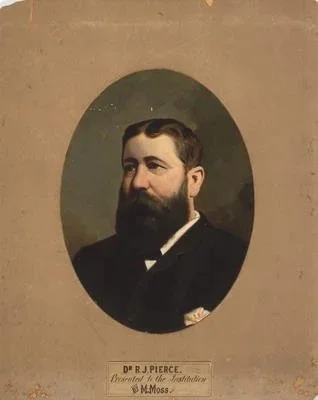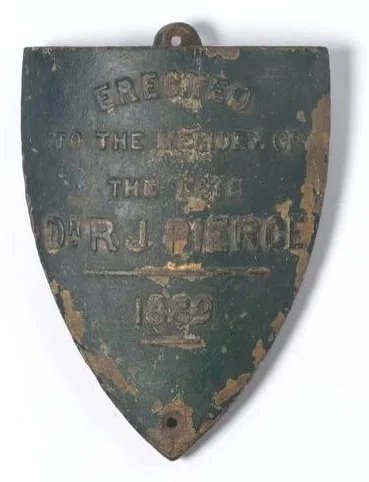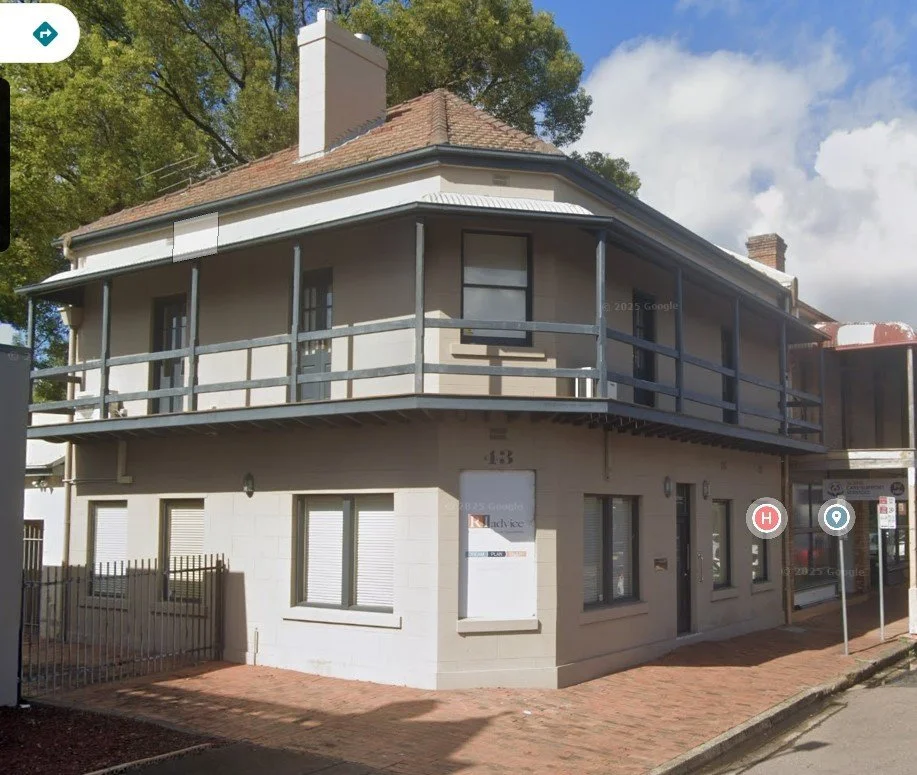Dr R J Pierce, loved nineteenth century medico
Portrait of Dr R J Pierce by Morris Moss
albumen print, paint
RJ (Robert James) Pierce (1841-89) was an Irish doctor and surgeon who qualified after studying at Dublin’s Royal College of Surgeons. Like many other Irish people of the nineteenth century, he migrated to Australia, arriving in 1864 on board the Tornado. He worked as a doctor in Melbourne, Newcastle and Muswellbrook (where in 1871 he married Martha Keys) before settling in West Maitland in 1875. He was to spend the last 14 years of his life in Maitland, establishing a medical practice in the former Albion Inn in High St, near the intersection with Church St, and conducting many surgical procedures at the Maitland Hospital on Campbells Hill.
Pierce’s Maitland life and death
Pierce developed a reputation as a physician with a particular regard for the poorer members of the community. He was elected an alderman on the West Maitland Borough Council and in 1888 he became the Mayor – the eleventh man to fill this position since the Council was constituted in 1863.
He was highly active in the community as President of the Maitland Hospital and senior Consulting Surgeon there, President of the Philharmonic Society (and possessor of a fine singing voice) and a member of a number of other Maitland organisations including the Fire Brigade Board (which he chaired), the Northern Jockey Club and the Hunter River Turf Club. He was also a member of the Maitland Lodge of Unity and the Microscopical Society (later the Maitland Scientific Society). In association with his medical work he also served as a coroner.
Dr Robert Pierce
(Wikitree)
As Mayor, Pierce laid the foundation stone of the West Maitland Town Hall on 26 January 1888, commemorating the founding of the Colony of New South Wales exactly 100 years earlier. Early in the following year he died, still in office and aged only 47, after having a seizure in High St near his home. A message from Muswellbrook, published in the Maitland Mercury, said something about the affection in which he had been held. It read:
What? The skilled physician, the sweet singer, the eloquent speaker, the gentle, kindly, warm-hearted man gone?
He was buried in the Bengalla Cemetery, just outside Muswellbrook, next to his wife who had died only a year after their marriage.
Developing a memorial
Immediately, as often happened in the nineteenth century when a well-known Maitland civic figure died, there was a move to create a fitting memorial. A meeting in the Old Masonic Hall in High St, attended by about 30 men of the business and professional elite of Maitland, West and East, discussed what sort of memorial would be appropriate and where it should be located.
During the meeting speeches were made and Pierce was lavishly praised. Some of the comments would today be considered ‘a bit much’: one speaker (West Maitland’s inaugural mayor, William Mullen) called him ‘the grandest man that ever lived in West Maitland’. More soberly, another said he had shown ‘kindness of heart to the poor more than to the rich’. A third speaker called him ‘a dispenser of charity with a liberal hand’. He was clearly a loved and respected figure in the community.
The meeting resolved to erect ‘a substantial monument’ to his memory. There was debate, according to the Maitland Mercury, about what the form and nature of the memorial. In the end, an elaborate circular cast-iron bubbler fountain with a lamp above it was decided upon. Its siting came down to three possibilities - Maitland Park (which was to become the site of several memorials in later years) or the town centre, either in front of the Town Hall or at the Maitland Mercury intersection of High St and Hunter St.
The intersection won out. A fountain in front of the Town Hall was thought likely to be obstructive to traffic in the busy main street.
The fountain cost £150, funded by a public subscription. Pedestrians, horses and dogs benefited for almost fifty years from the drinking water it provided, but High St changed substantially over that time. A street of slow-moving horses, sulkies and pedestrians became a thoroughfare increasingly dominated by trucks, buses and cars. The High St/Hunter St intersection was deemed by the Council, with the fountain in place there, to be a danger spot. Not everyone agreed, but in January 1939 the structure was removed at Council’s behest.
The Pierce Memorial fountain (front right)in its original location at the Mercury corner
(K Magor collection)
Further photos of the fountain in its original location
click on above images for larger views
Left to right: a 1908 postcard; a photograph taken in about 1909; from the publication With Compliments, West Maitland, Thomas Dimmock, 1922.
(Picture Maitland, Maitland Libraries)
Where it went is not clear. It was not re-erected in an alternative location like Maitland Park, the site of many other memorials. In all likelihood it went to a council tip and was thus buried and lost to posterity. The plaque from the fountain, inscribed ‘Erected to the memory of the late Dr RJ Pierce 1889’, was retained in the vestibule of the Town Hall. Now tarnished to the point of being virtually unreadable, it resides today in the Maitland Library Collection.
Commemorative plaque that was attached to the fountain
(Maitland Libraries Collection LIB2022.040)
The plaque is the focus of a story posted to Museums and Galleries of NSW Storyplace website. Visit: Sign of Respect: Dr Pierce’s Memorial Plaque from Maitland’s Fountain, Storyplace, Museums and Galleries of NSW, 4 Nov 2022.
The Pierce Memorial Trained Nurses Home in Elgin St, for which Pierce at the time of his death was raising money, was named in his honour. This establishment was linked to the Maitland Hospital and provided home nursing services.
The building that housed the Pierce Memorial Trained Nurses Home
(Google Earth)
The Maitland Hospital Collection also holds a commemorative bed plaque honouring Dr Pierce, and some of the minute books for the Pierce Memorial Nurses’ Home.
References
Collections Maitland, Maitland City Council.
Keys, Chas, ‘Our past: Dr RJ Pierce, loved nineteenth century Maitland medico’, Maitland Mercury, 9 February, 2024
Maitland Mercury and Hunter River General Advertiser
Rudkin, Val, Who? What? Where? People of 19th century High Street, Maitland, Maitland and District Historical Society, 2015.








